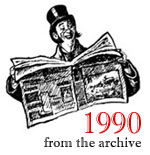
Toward Overcoming the Spirit of Resentment in a Polarized Church
CAN A DIVIDED CHURCH HEAL A BROKEN WORLD?
Twenty-five years after the Second Vatican Council, despite all its benefits, the Catholic Church continues to suffer from an unintended side-effect, resentment, which corrupts truth and suppresses charity. It is a bi-partisan disease, affecting Church liberals and conservatives alike, robbing them of objectivity and galvanizing them into ideological camps. I want to propose that resentment can be healed, and that such healing is absolutely essential if we, as individuals and as a Church, are to proclaim the gospel.
Immediately following the Council, resentment was primarily the prerogative of those who would come to be known as conservative Catholics. For some, the liturgical, sacramental, and devotional changes, and the manner in which they were implemented, caused alienation. Others felt betrayed by priests, religious, and theologians who, in the name of “the spirit” of the Council, seemed to abandon not only the Church’s cultural inheritance, but also elements of Catholic doctrine and morals. Conservatives compiled lists of grievances. They cited instances of Jesus’ divinity and bodily resurrection being questioned or denied. To their consternation, they saw some dismiss sin as a medieval relic and place moral absolutes in the museum of theological history. The liberal response to Humanae Vitae provoked their anger and bitterness, later to be refocused on the issues of homosexuality and feminism. Resentment alone did not nurture conservative associations and publications, for there was a legitimate concern to protect truth, but it was surely mixed with the milk upon which these fraternities and publications fed and grew.
Liberals, immediately following the Council, often became angry with their conservative counterparts for foot-dragging, but by and large in those days they were not a resentful lot. They may have been resentful of perceived and real past injustices and injuries, but they confidently believed they were riding an irreversible wave of renewal. In the midst of this new enthusiasm, old resentments could easily be cast aside, or at least be concealed. After all, liberal influence was becoming decisive in chanceries, parishes, schools, CCD programs, universities, academic associations, and religious orders.
But the appearance of Pope John Paul II and, with him, Joseph Cardinal Ratzinger became the catalyst for rejuvenated liberal resentment. A new swell of theological conservatism seemed to have returned. Much that had been won since Vatican II seemed jeopardized. The Kueng, Hunthausen, and Curran affairs, plus the appointments of apparently conservative bishops, symbolized and effected this conservative papal hegemony. Fear and anxiousness among liberals intensified (and with some cause) as conservatives rallied with renewed vigor around the papal flag and the disciplinary authority of the Congregation of the Doctrine of the Faith, regularly referred to in liberal publications as “the former Holy Office.”
You May Also Enjoy
She required that we ban, Those damned suffixes, "man."
Was Hans Urs von Balthasar really as goofy as his fans make him sound?
Review of The Priest

